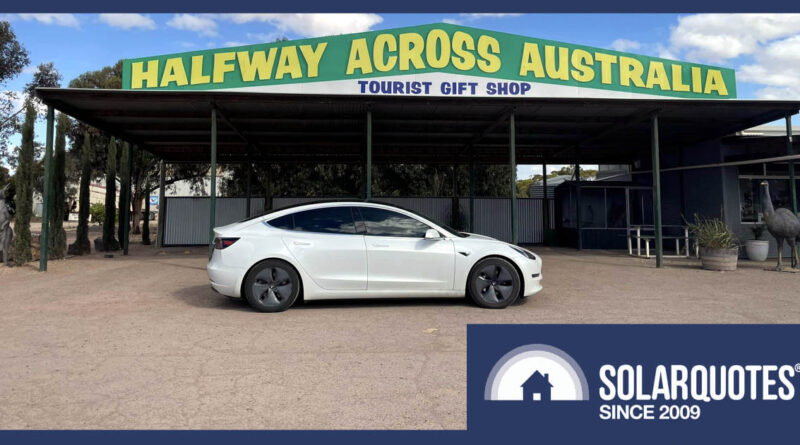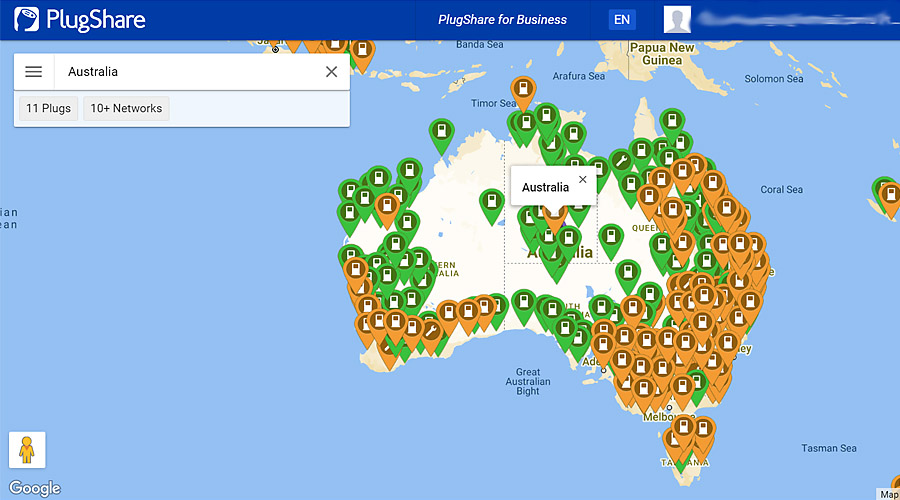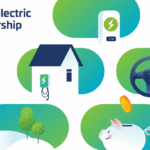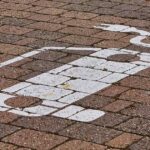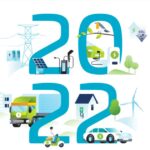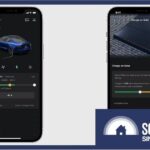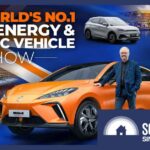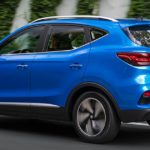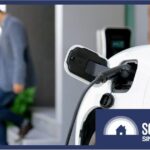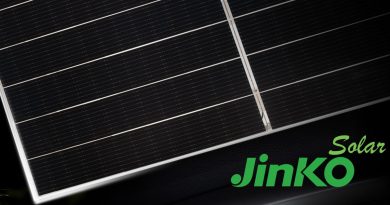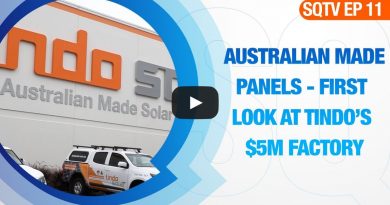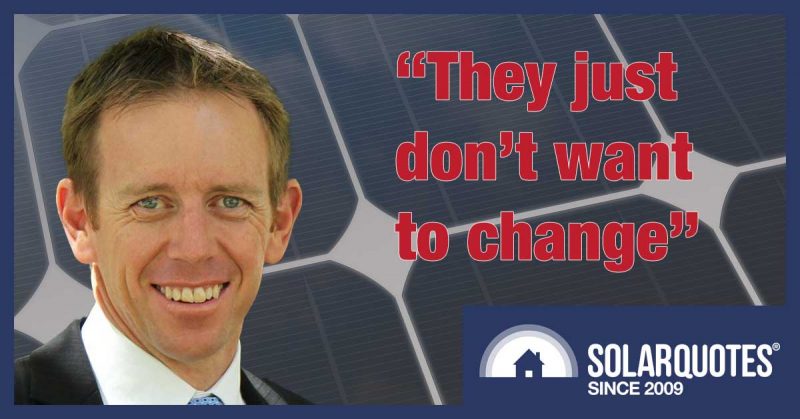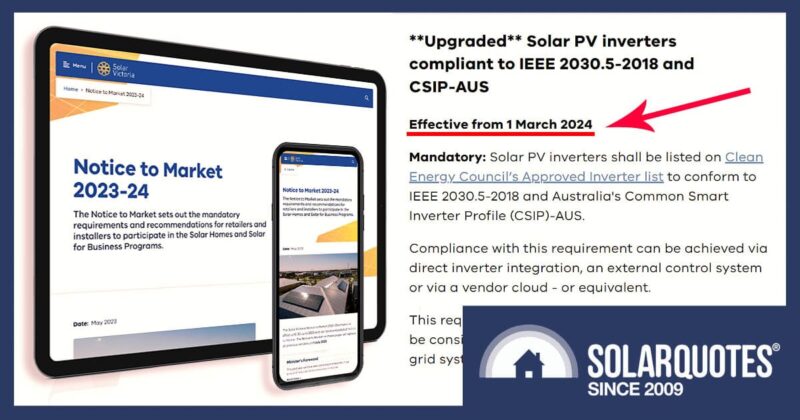What Rob & Sally Learned Driving A Tesla 9,630km Through The Aussie Outback
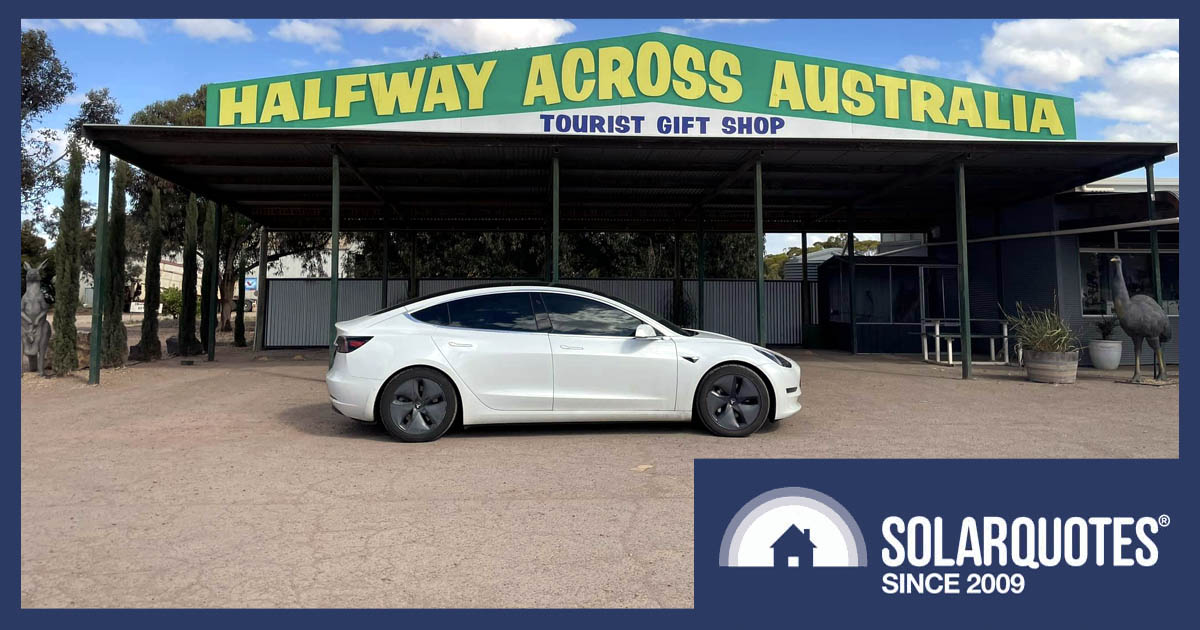
Rob and Sally needed a holiday, so they jumped in their EV and drove from Sydney to Perth – and back again. They wanted to know what the experience would be like, and thought it would be a good opportunity to show the world how easy it is to drive from the Pacific to the Indian Ocean in an electric vehicle.
The thing is, as they found out, they’re not the only ones doing it. EV sales in Australia in 2022 were up 65% from the previous year, and owners are reaping the benefits of having cheap fuel and seeking out new frontiers with their cars.
Rob and Sally are passionate renewable energy advocates. Rob runs a YouTube channel (@SydneyEV) where he talks about aspects of EV ownership, include charging, infrastructure, EV features, and dealing with range (not rage). Sally makes plenty of appearances too, and together they make a great team. We’ll undoubtedly see videos of this epic trip on the channel soon.
In the meantime, here’s an outline of their trip and their thoughts about the journey. But first, a shot of their Tesla 3 overlooking the Great Australian Bight near the WA-SA border.
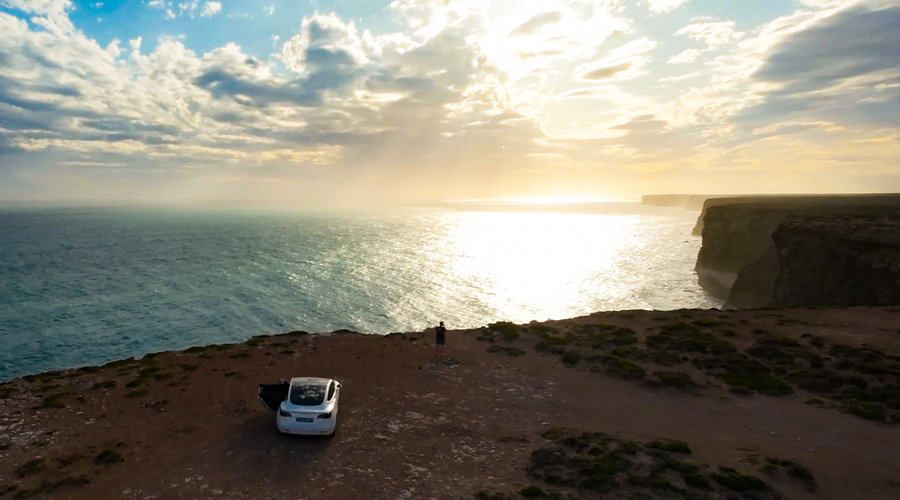
A drone shot of Rob and Sally’s Tesla 3 overlooking the Great Australian Bight near the WA-SA border.
Planning The Trip
I asked them how they managed to charge the vehicle. Did they plan the trip before they left, or just hit the road and see what happens? Rob says:
“The only part we planned was from Sydney to Broken Hill. Many of the sites on that route in the NRMA network only have one charger, so you’ve got to make sure they’re working before you go. We simply checked on PlugShare to make sure they’ve recently been used, then off we went.”
For non-EV owners – PlugShare is a website and mobile app that helps electric vehicle drivers find charging stations in their area. Users can search for charging stations by location, connector type, and availability and view reviews and photos of the stations. The PlugShare map is also available here on SQ.
Another minor detail that’s handy to know – their Tesla 3 conservatively gets 370km on a fully charged battery and about 440km around town. That’s much better than the 200km per tank I was barely scraping out of my 1972 Honda K2 motorcycle when I made the same trip.
Charging Equipment
This is a list of assorted chargers, cables, and adapters Rob and Sally took with them just in case, and whether or not they were needed:
- Standard single-phase Tesla charger (tick).
- 15A single phase extension chord (tick).
- 3-phase charger (tick).
- Standard 3 phase adaptor for above (tick).
- 32A 3-phase extension chord (not needed).
- Standard Type 2 to Type 2 extension (not needed).
- J1772 plug to Type 2 adaptor (not needed).
- 32A 3 phase to 15A single phase adaptor (not needed, thankfully) – hey guys, I’m not sure if this is legal! I can’t see any 15A overload protection on this baby!
- 10A to 15A single phase plug adaptor (not needed) – this one’s legit, complete with the appropriate sized circuit breaker.
What we took with us to #charge on the #EV #Roadtrip across the Nullarbor to #Perth. 3phase mobile charger, the OEM #Tesla mobile connector. A 15 amp extension cable and that’s pretty much all we actually used. #ausev #evcharging #power. pic.twitter.com/Y04ClbsEjl
— Sydney EV 🔋☀️ (@sydney_ev) December 22, 2022
Internet
You can’t go anywhere without the internet, right? Rob and Sally went top shelf. They purchased a Starlink kit that includes a satellite dish and modem, which gave them high-speed broadband at up to 150 Mbps anywhere on the route, even while driving.
They were able to track the car the whole way and collect data such as GPS position, average speed, average charge times, power usage, and a whole lot of other stuff they’ve yet to collate.
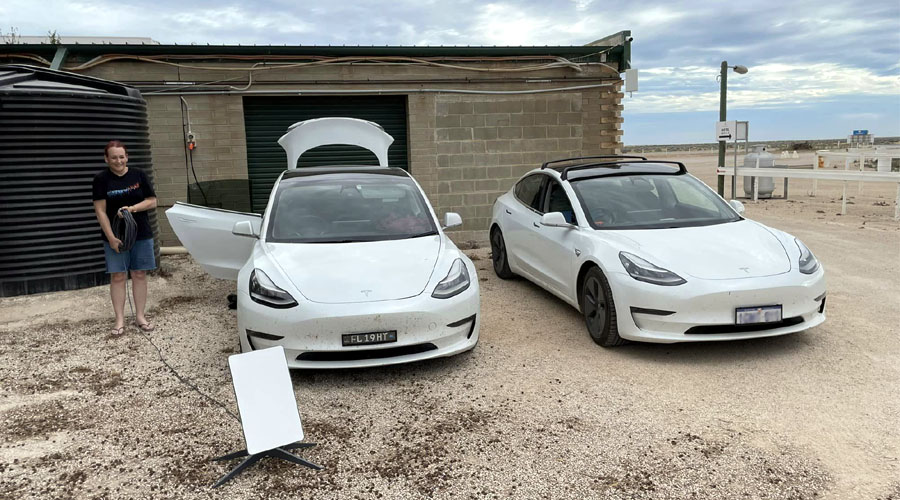
Charging at the Nullarbor Roadhouse with the Starlink dish set up, and another Tesla owner arriving on his way from Perth to Tasmania.
Road Tripping
Everybody’s doing it! Well, not everybody, but it’s more common than you’d think. They met quite a few like-minded EV owners crossing the Nullarbor. One was a Perth girl they met in Poochera, SA, who’s just finished her return trip from Perth to Sydney in a BYD Atto 3. Read about her adventures and give her a thumbs up on FaceBook – Atto Gal’s EV Adventures.
In Ceduna, another Tesla was charging at their hotel. He was heading from Brisbane to Perth. Twice Teslas pulled in to charge at Nullarbor Roadhouse on both trips there and back. On several occasions, Teslas whizzed past them, going the other way.
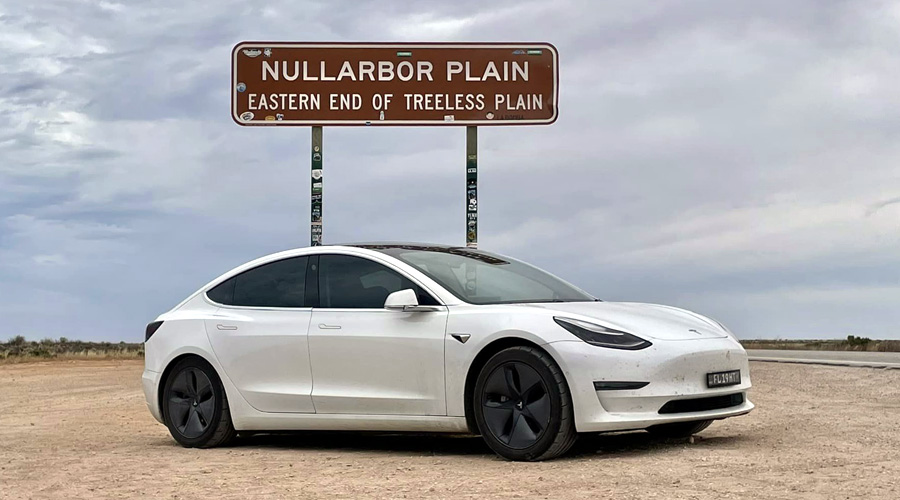
The eastern end of the famous Nullarbor Plain.
The way the rural and outback charging network is at the moment, it helps to have a casual approach for a trip like this. Enjoy the ride rather than be focused on looking at the clock: “are we there yet?”
Sally says: “As far as charging goes on the route to Perth, after Broken Hill there’s not much in the way of DC fast chargers until you hit WA. You really have to take it day by day because there’s no guarantee you’ll reach your destination at a particular time. Unfortunately, South Australia is a bit of a desert when it comes to DC fast chargers, apart from the southeast corner. The most westerly located fast charger on our route was in Clare. Other than that we had to rely on 3-phase power outlets until WA.”
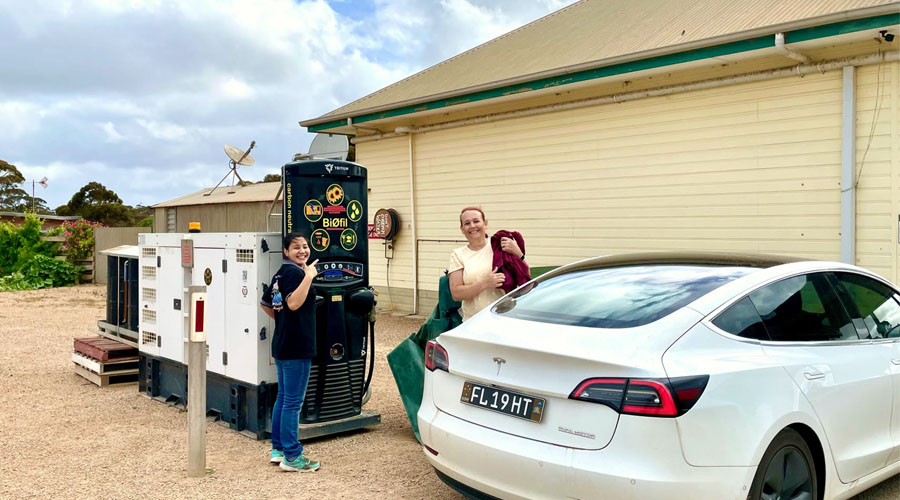
Recharging at Caiguna on 50kW DC fast charger powered by cooking oil.
Fun fact:
A 32A 3-phase outlet can charge at a rate of up to 22kW, depending on the vehicle. Rob and Sally’s Tesla will only charge at 11kW with an AC charger. DC fast chargers start at 22kW, and some can charge up to 350kW. The process is much quicker with DC chargers because they don’t have to convert (rectify) AC to DC, and so they can inject high DC current straight into the car battery.
For example, a 20kW DC fast charger can theoretically charge a 60kWh battery in 3 hours (from 0%). An AC charger will take about twice as long. You can read more about EV chargers in Finn’s EV Charging 101 Guide.
The Fuel Bill
How much did it typically cost to fill ‘er up?
“It depends. Some places have a flat fee, and some ask for a donation to the RFDS or their local bush fire service. Some will charge an hourly rate, and others by the kWh. Some hotels provide free charging with accommodation. All this information is on Plugshare and updated with prices by the active community on there,” says Sally.
The average cost of charging on a fast charger was approximately $0.40 per kWh, whereas the slow roadhouse chargers cost about $1 per kWh. The total cost of charging was $714 for the 9,630km trip, including all Tesla Superchargers and Chargefox DC fast charging.
Compare that to the average petrol car (9L/100km) with an average fuel price on their route of $1.95/litre, spending a total of around $1,700 on petrol. That’s a saving of almost 60% for the EV. Considering Rob and Sally usually charge at home with surplus solar energy for free1, things are looking good for the economics of electric vehicles.
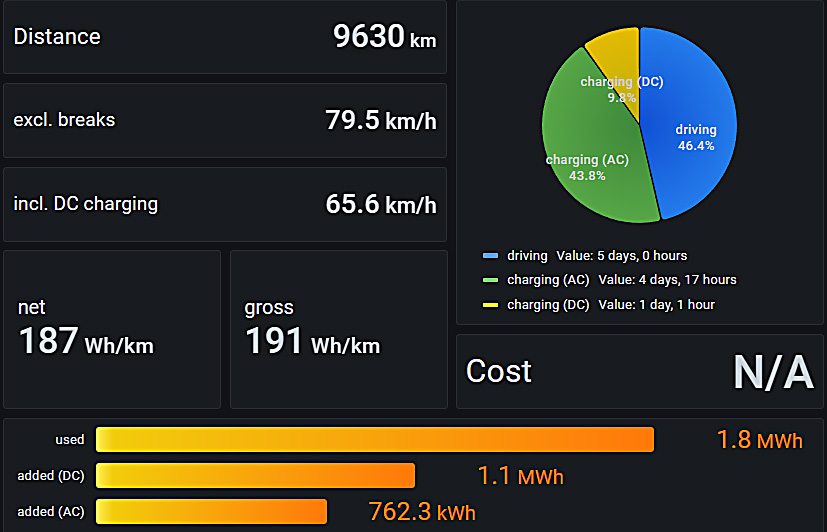
A glimpse at the energy stats for the whole 9630km trip.
Anything Learned From This Trip?
Phone Ahead!
“That way you’ll know if there’s a charger available. It’s easy. Put the route into Plugshare. It gives a list with details of all the chargers on that route with phone numbers,” says Rob. “Phone up and give them your ETA. Every place was happy to see us and very friendly.”
Charger Reliability
Forget range anxiety. That’s not really a thing for EV owners, it’s more like charger reliability anxiety.
“You don’t always know if a charger will be available or working. Reliability on the non-Tesla network is, putting it mildly, a little lacking right now. Unfortunately, this is a big problem in Australia that needs to be sorted,” says Sally.
Car Energy Management
They learned to trust the range of the vehicle and found out what it was capable of. Like a petrol vehicle, slowing down saves not only lives, but also fuel.
They pushed the envelope a bit too far for my liking, though! Rob says:
“On the return trip when leaving Madura, our destination that day was Nullarbor Roadhouse. The car told us we would arrive with -5% charge (translation: not make it!) By adjusting our speed we were able to reassess the energy demand on the go, and drove past two roadhouses (Mundrabilla and Border Village) without stopping, arriving at Nullarbor with 2% left in the tank!”
Anyone that knows this remote stretch of road would agree that they have nerves of steel!
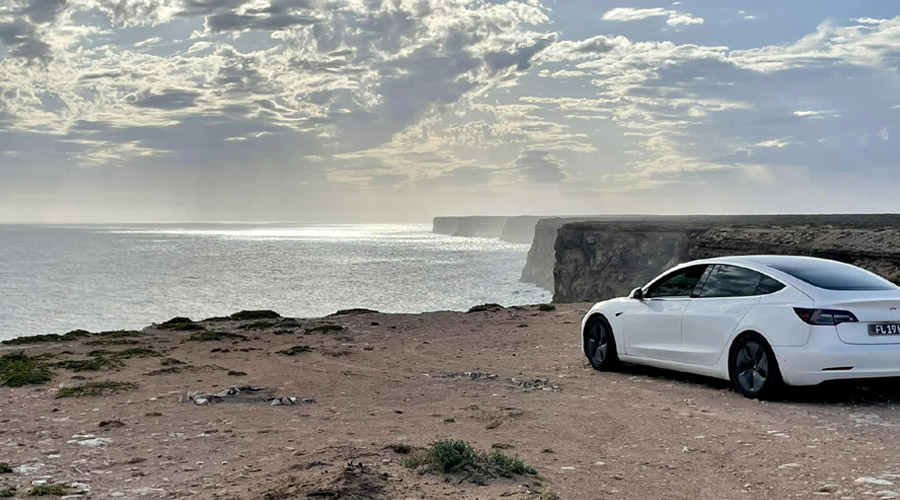
Another lookout on the WA side of the SA border.
Improvements Needed
As stated above, the number of chargers available and the reliability of the non-Tesla network are a giant roadblock to mass EV adoption in Australia right now. Fortunately, this will change, but it can’t come soon enough.
Not every potential EV buyer wants a Tesla, for whatever reason, so 3rd party chargers need to be reliable and in large numbers. Most Tesla sites have at least 4 serviceable chargers, while many towns have only one 3rd party charger, which is often broken.
Why and where the answer lies is anybody’s guess. Please weigh into the conversation with answers if you have any.
In the meantime, here’s a brief outline of Rob and Sally’s route, including distances, maps, and charging stops with charger details where possible.
The Route
GPS tracking of the whole route.
Day 1 – Sydney to Cobar (684km)
The first charge was a quick top-up at Bathurst (120kW Tesla Supercharger) while buying last-minute road snacks, then the next stop was Dubbo (120kW Tesla Supercharger), then a quick top-up at Nyngan for lunch (NRMA DC fast charger) before heading to Cobar for the night (75kW NRMA fast charger).
Day 2 – Cobar to Jamestown SA (785km)
A recharge at Wilcannia (75kW NRMA fast charger), then to Broken Hill (50kW NRMA fast charger), and arrive at Jamestown staying overnight with free charging at Jamestown Railway Hotel (Tesla 22kW charger).
Day 3 – Jamestown to Ceduna (597km)
A five-hour recharge at midday in Kimba (32A 3 phase outlet – $50 donation to RFDS). Arrived at Ceduna with an overnight free recharge at the Motel (11kW Destination Charger).
Day 4 – Ceduna to Mundrabilla WA (580km)
Lunch and a recharge at Nullarbor Roadhouse for 5 hours (32A 3 phase outlet – $50 donation to RFDS) before arriving for an overnight free recharge at Mundrabilla Roadhouse (32A 3 phase outlet – free with accommodation).
Day 5 – Mundrabilla to Norseman (621km)
Recharge at Madura Pass Roadhouse for 2 hours (22kW CCS2 DC charger – $20 donation), then another stop at Balladonia for 1.5 hours (22kw CCS2 DC charger – $1 per kWh), arriving at Norseman Caravan park for overnight slow charging on a 15A single phase outlet.
Day 6 – Norseman to Jerramungup (470km)
Charged at Esperance Country Comfort Motel for 2 hours while doing laundry for a $10 fee (11kW Destination Charger) before heading to Ravensthorpe for a recharge (11kW Tesla Destination charger), then overnight at Jerramungup Caravan park (22kWDC fast charger).
Day 7 – Jerramungup to Perth (441km)
One 10-minute stop at Williams (250kW Tesla Supercharger), then spent a day in Perth before heading to Bunbury (Chargefox 50kW RAC Electric Highway network – 45c/kWh).
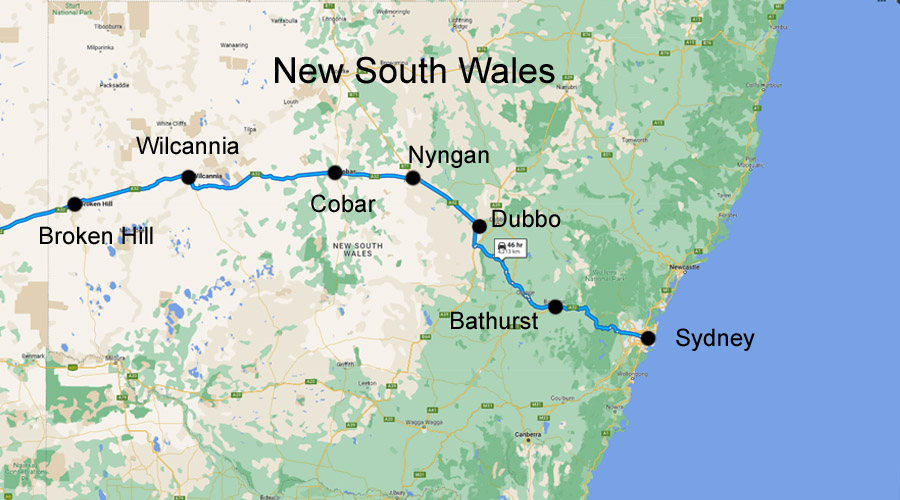
NSW charging stops east to west.
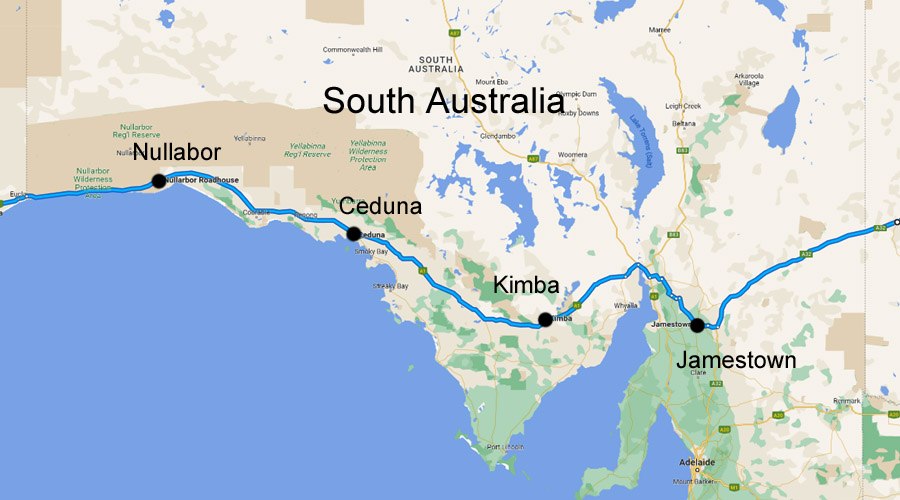
SA charging stops east to west.
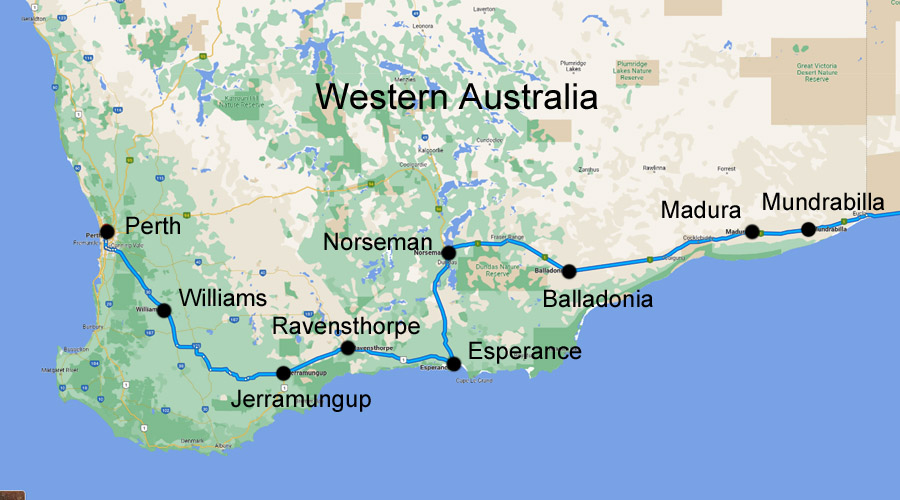
WA charging stops east to west.
Return Trip
Day 8 – Bunbury to Augusta (145km)
Travelling via Margaret River, then overnight stay at Augusta (Chargefox 50kW RAC Electric Highway network – 45c/kWh).
Day 9 – Augusta to Lake Grace (409km)
Overnight stay at Lake Grace (Chargefox 50kW – public donation for the Perth to Esperance Electric Vehicle Highway).
Day 10 – Lake Grace to Norseman (400km)
Travelling via Hyden with a midday charge at Hyden Roadhouse for 2 hours (32A 3 phase outlet – 40c/kWh), then a dirt road to Norseman and an overnight stay at the caravan park again (15A single phase outlet).
Day 11 – Norseman to Caiguna Roadhouse (372km)
Recharge at Caiguna on a 50kW DC fast charger powered by cooking oil. Overnight camping ($50 flat fee).
Day 12 – Caiguna to Nullarbor Roadhouse (534km)
Topped up at Madura (22kW CCS2 DC charger – $10/hr donation to RFDS). Leaving Madura with an estimated -5% on arrival, passed Mundrabilla and Border village chargers as reducing speed to 90Kmph increased the car’s range. Arrived at Nullarbor roadhouse with 2% remaining in the battery. Charged overnight at Nullarbor Roadhouse again (32A 3-phase outlet – $50 donation to RFDS).
Day 13 – Nullarbor Roadhouse to Ceduna (297km)
Left at 5:30 am as another EV driver arrived from Melbourne on the way to Perth at 5 am. Arrived at Ceduna mid-morning, relaxed in town with a free overnight recharge at Ceduna Motel (22kW Tesla Destination charger).
Day 14 – Ceduna to Port Augusta (469km)
Mid-way charge at Poochera Hotel (32A 3 phase outlet – $20 fee). The hotel owner wants to install fast chargers as now many EV drivers arrive to charge, and the local petrol station has closed down. Overnight charge at Port Augusta (11kW Destination Charger).
Day 15 – Day trip Port Augusta to Woomera return (362km)
Overnight stay at the same motel in Port Augusta and a recharge (11kW Destination Charger).
Day 16 – Port Augusta to Horsham VIC (736km)
Charge at Clare Valley Supercharger (150kW Tesla Supercharger – 51c/kWh), then at Keith (Chargefox 100-350kW DC fast charger), and on to Horsham for an overnight stay and charge (type 2 charger).
Day 17 – Horsham to Sydney (1060km)
13.5 hours total trip time, including charging at Bendigo (120kW Tesla Supercharger), Euroa (120kW Tesla Supercharger), Albury (120kW Tesla Supercharger), Gundagai (120kW Tesla Supercharger), Goulburn (120kW Tesla Supercharger), then home to Sydney.
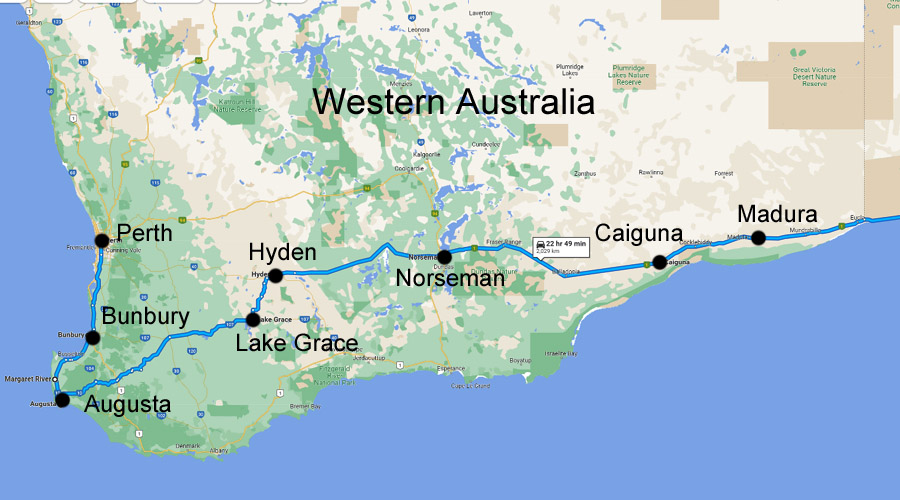
WA charging stops west to east.
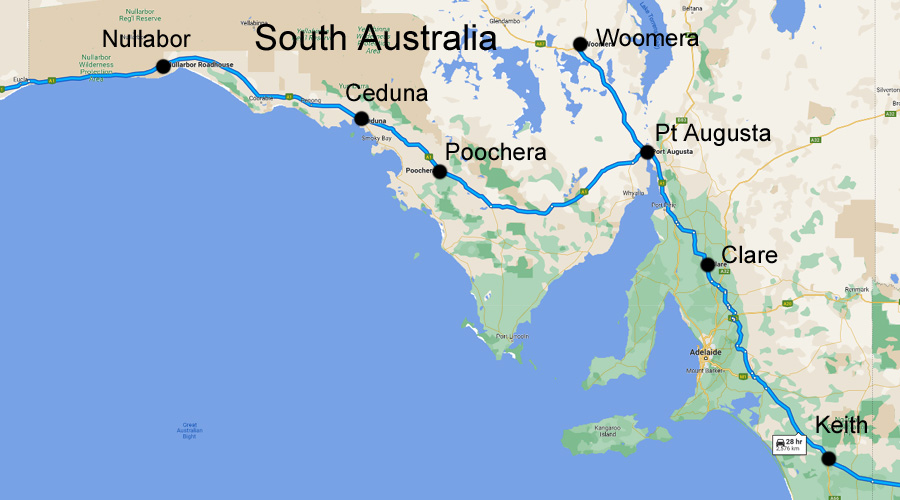
SA charging stops west to east.
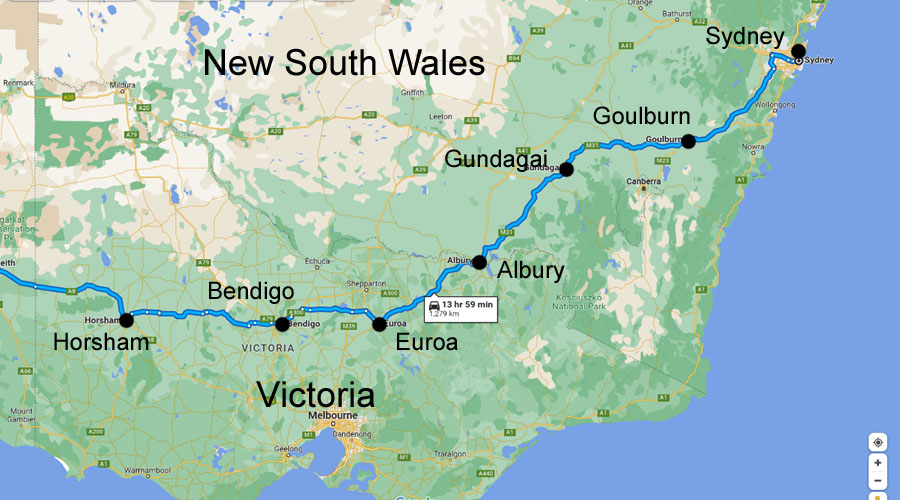
Vic and NSW charging stops west to east.
What Are You Waiting For?
Jump in your EV and get on out there and explore the world!
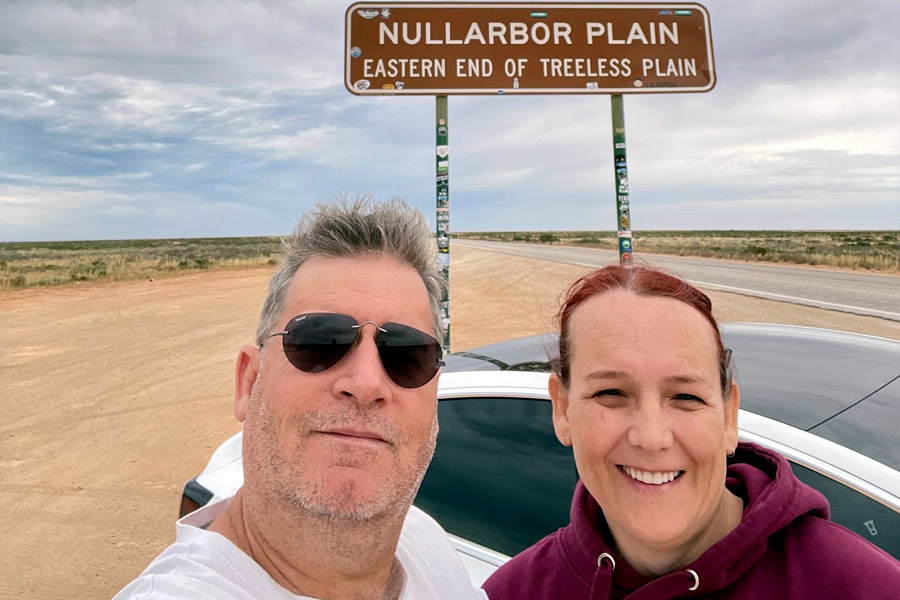
Obligatory selfie at the most famous landmark in this article.
Footnotes
- Using excess solar to charge an EV is not normally free, because you have to account for the relinquished feed-in tariff you would have otherwise received. ↩
Original Source: https://www.solarquotes.com.au/blog/sydney-perth-ev-trip/

